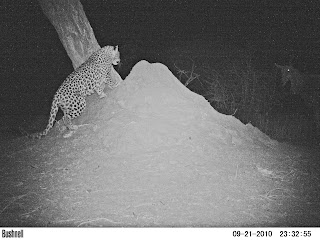CCF has carried out a number of camera trapping surveys, and also maintains a network of cameras positioned for ongoing monitoring of the wildlife on our land. While we are mainly focused on cheetahs, there are many other species out there, and the cameras will trigger no matter what passes them by. In this series of weekly blog entries, I will use these pictures to illustrate some of the wealth of animal life in Namibia - one species per week. I hope you will enjoy seeing a little more of our world here in the bush.
Female eland with abnormal left horn
The common eland (Tragelaphus oryx) is one of the biggest antelopes in the world. With a huge stature, brown coat and twisty horns present on both males and females, these are very elegant and impressive animals. Males, with more robust horns and a large dewlap, can weigh nearly one tonne, with females ranging from 300-600 kg. They can measure between 2 – 3 metres in body length and live in herds of up to 60 individuals. Occasionally, groups of up to 1,000 have been seen in the rainy season!
Common elands are of Least Concern according to IUCN RedList classifications, with a global population estimated at 136,000, with roughly 50% of this population resides in protected areas. Historically, their range extended throughout southern and eastern Africa, but this has contracted by more than half due to the increase in human populations. Their populations were also severely affected by civil wars across Africa. Being a sought-after trophy animal, their numbers have increased on game farms across southern Africa. Due to this, their population appears to be stable and possibly increasing in Namibia. Although not the most common antelope seen on CCF land, we do observe them quite regularly both on camera traps and game counts.
Being very adaptable ruminant antelopes, they can thrive in a diversity of habitats ranging from sub-deserts to alpine moorlands. They are browsers and can migrate long distances in search of good forage. Being picky about their food, they choose plants high in water, and therefore are not dependent on water. This may be why elands are more often seen feeding at night, when vegetation has the most water content. They can live up to 25 years in the wild.
Stay tuned for our next Animal of the Week next week!
Best wishes,
Niki Rust
Ecologist
Ecologist
Cheetah Conservation Fund
All photos copyright (c) Cheetah Conservation Fund 2012








taking time along with real hard work to make a very good article
ReplyDelete